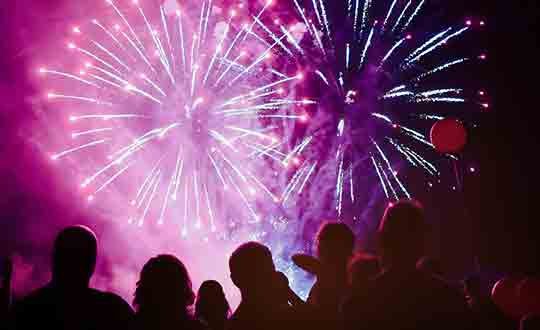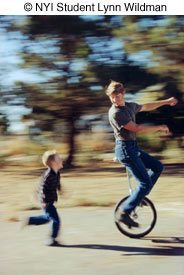
Here's a really great father-and-son photo. While not every Dad can ride a unicycle, NYIP student L. Wildman took advantage of strong side lighting and used the panning technique to record this exciting photograph. Think about how much this photo will come to mean over the years in this family's photo album.
Over the years I've watched a lot of families grow up. The one I grew up in. The family I enjoy today. My sisters' families. My Uncle John's family. My nephew Andrew's new family. And, like lots of dads, I'm the principal family photographer. Since, as you might guess, there are a lot of cameras in my house, everyone takes a photo now and then, but most of the time, I'm the one with my finger on the shutter. Consequently, there are few Father's Day pictures in our albums.
Last year I went to my niece's wedding in Michigan. I had a wonderful time at the ceremony, took a few pictures, and got to meet a lot of interesting people. There was a family dinner the night before the wedding, and a very relaxed barbeque in a park in Ann Arbor the day after. I mention this weekend because it's probably something like a weekend or two you'll enjoy this summer – a family event, perhaps a wedding or a reunion, or just a big holiday weekend backyard cookout or a party down the road.
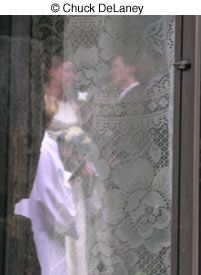
My niece got married in the garden of an old bed-and-breakfast inn. I didn't want to copy the work of the wedding photographer, but I spotted this reflection of the happy couple in one of the inn's windows, and I liked the way the lace curtain softened their reflection. I took this from my seat during the wedding.
I observed something interesting watching who took photographs over the weekend. About half the guests were friends and classmates of the happy couple. My niece was finishing medical school, and her husband had just completed law school. Among their friends and classmates who were young and single, the women were the ones with cameras. But among the slightly older guests, including families of many different types, it was the dad packing a camera, a video recorder, or both.
Perhaps this reversal will diminish over time, but it does make a certain amount of sense. No matter how "hands-on" a Dad can be in this day and age, there are lots of times in a young infant's life when Mom gets the first and most strident call – provided she's available. So Dad starts out as the family photographer and is likely to continue the job over the following years. In my opinion, it would be better if the picture taking were shared more from the start, but that's a topic for another time.
With Father's Day approaching, the focus should be on Dads. Since he's toting the camera, it's no surprise that too often Dad gets left out of the family album, and especially out of the group photographs. Chances are, he's behind the camera.
This Father's Day, or, if not exactly on June 19th then sometime this summer for sure, why don't you give yourself a self-assignment to take a picture or two of Dad to put him back in the picture? And make sure he's in your family album.
If you're reading this article, you're probably interested in photography. So the idea of a self-assignment is a great one. It gives you a purpose. It gives you reason to ask for the cooperation of others, maybe even take control of the set and issue a few orders as you compose your Father's Day pictures! – "Don't look at the camera. Dad! Please sit down and put your hands in your lap. Now smile! – It doesn't get better than that.
So here's your self-assignment:
- If you've got a Dad, then your assignment is to photograph him.
- If you are a Dad, then your assignment is to make a family portrait, and perhaps a self-portrait or two.
- If you don't fall into either of the above categories, pick a hard-working Dad that you know, and photograph him.
- I'm going to describe four specific types of photographs and offer some tips about how to capture each one best with your camera.
Picture One: A Portrait of Dad
If you're going to take a serious portrait of your father, I suggest you take some time to think about what would show him doing something that he loves, perhaps something related to his work or his favorite hobby or leisure time activity. Perhaps it's fishing, or flying, or building something in the garage. Maybe it's playing video games, or practicing medicine, or jumping out of airplanes.
Find a way to incorporate that interest in your photo. That doesn't mean you have to be in the airplane or knee-deep in a trout stream. You might just sit Dad by a nice patch of window light with his reel, or stethoscope, or game controller in his hand. Or sitting along side him on a table we might see some woodworking tools, or a book and his pipe. As with all portrait subjects, it's important to give him something to do with his hands.
At the New York Institute of Photography, we have Three Guidelines for Great Photographs. They're simple, and those guidelines are first thing we teach students, and we return to them over and over again. I'm happy to share them with you, for free:
Guideline One: What's the Subject of My Photograph?
Guideline Two: How Can I Focus Attention on the Subject?
Guidelines Three: Is there any thing distracting in the photo, or any way to simplify the picture?
To make a portrait of your father, try to show him as the person you've come to know. That will make him more of a subject and not just a headshot. Or, another approach would be to show your father as he would like to be seen. Don't just put him against a wall and pop the flash. Give the matter some thought. What clothes should he wear? Where should you take the photo? What is the best lighting and time of day?
If you photograph your father while he's sitting in a chair, consider getting the camera lower down to his level, so you're not pointing it down on him. In fact, since we want to look up to our fathers, if you shoot Dad from a low level you can increase his stature in the setting.
While you may want to use your camera's flash to light up your subject, the harsh light of direct flash is not always flattering. Consider using available light, window light, or open shade outdoors as an alternative.
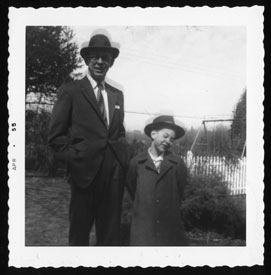
Here's one of the few pictures I have of me and my Dad. It was taken in the backyard in the mid-1950s. Given the camera shake in the picture I suspect one of my sisters took this. You can see my father knew how to strike a pose, but the shade cast by the brim of his hat obscures his face to a degree. I wish I could say the way I have my head turned shows that I had an acute sense of photographic lighting at a very young age, but I was probably just giving my sister a hard time. This was taken with the trusty Kodak Brownie Hawkeye, a very popular camera in its day. Note the square format (the Hawkeye took 620 film) and the deckled edge of the print.
If your father likes to be surrounded with family, you may get the best expressions when you have other people around while you conduct your photo session. If, on the other hand, your father is a more reserved and private person, you may get the best results by setting a time and place where you can be alone with him.
After you've decided on how to set up and light your Father's Day pictures, don't forget to consider those two other Guidelines when you're looking into your camera's viewfinder. For most portraits, the best way to focus attention is to make your subject large in the frame. Is there anything you can take out of the photo to make it clearer? If you've got Dad in his favorite reading chair in the living room, make sure there's not a box of tissues in the corner of the frame. If there is, move it out of the picture. Like any good director, make sure the "set" is tidy.
Picture Two: A Family Group Portrait
I don't care if Dad's family is currently just Uncle Jack and the three-legged dog or a tribe of a dozen or more. Get the family together, and try to build your composition out of triangles. Remember that the camera tends to make people look farther apart, so get them close together. They can stand, sit, or rest on the ground or a corner of a building. Aim to show the relationship between the subjects.
Relationship is best shown in several ways. First, if the family is close, why don't they put their arms around each other? My friend Monte Zucker, the eminent wedding and portrait photographer, often poses family groups as they recline, and encourages them to lean on each other. He feels that members of today's families are often called to support one another, and he wants to show that in his images.
The second way to show relationship is to have everyone looking in the same direction. That could be at the camera, or gazing off at a single spot in the distance. When people are looking in different directions we tend to get confused about the relationships. If you're photographing a big group everyone could look at Dad, or for a more demonstrative photo, they could even point at him or put an arm around his shoulder.

This picture was taken in the fall obviously, but it's a great candid photo of father and son in the pumpkin patch. Don't despair if it takes you until the fall to complete this assignment.
Picture Three: A Family Group Portrait with you in it.
This is a little trickier and most likely requires that you use a camera that has a self-timer.
This usually means that you'll need to also find your manual and figure out how the self-timer works. In a digital model, you'll probably need to find some menu. On various models you'll find all kinds of different buttons and switches, but on most cameras there is a self-timer of some sort. You'll also need a tripod to hold your camera steady while you frame up the shot, pose everyone, and then trip the timer and hastily make your way into the photo.
If you set up this kind of photo as one of your Father's Day pictures, you'll find it is harder to direct your subjects since you're no longer in front of the camera. I suggest that you help them by counting down until the camera actually fires, and direct them all to look into the camera's lens.
Another approach to this type of picture is to enlist the help of a stranger, but that may not be as much fun. Besides, who knows if stranger you enlist knows how to take a picture? I suggest the do-it-yourself approach.
Picture Four: A Self-Portrait
I've saved the best for last. Self-portraits are fun, easy, and the subject is always ready when you are, doesn't get paid, and won't talk back to you. What could be better?
You might choose an informal technique such as simply pointing the camera at yourself.
As with Photo Three: the family group portrait with you in it, you can use your camera's self-timer to place yourself in a setting and then, after a bit of rehearsing, release the timer, get into the set and take your pose before the camera fires. This technique can take a little practice, but it has lots of possibilities.
If your camera accepts it, you can obtain a cable release of some sort that will allow you to fire the camera while you're in front of it. In olden days this could be done with an inexpensive air-bulb release that screwed into the shutter release. Today's electronic cameras don't offer such easy solutions. You'll have to look at your instruction manual and possibly the company's Web site to determine if this is an option for you — and worth the trouble for high quality Father's Day pictures. There may even be a wireless gizmo you can obtain for the job. Whichever method you choose, you have no excuse for not getting this picture taken this summer.
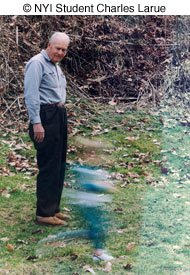
This is a grandfather and grandchild, but it's another great idea. Here, NYI Student C. Larue used a slow shutter speed (and probably a tripod) to blur the running child as Granddad (or Dad) watches and wonders at the energy of youth.
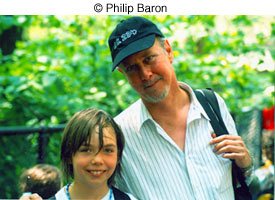
Enough, you get the idea and you have your assignment. Now go to it, and to one and all, Happy Father's Day!



